Figure Skating
Figure skating is a sport for solo skaters and couples, in which style and technical skill are tested. There are four categories of amateur competition: single skating for men and women, pairs skating, and ice dancing. Skaters may progress from the pre-novice level through the novice, junior and senior levels. Teams of up to 20 skaters may compete in the discipline of synchronized skating. Single and pairs skaters are judged on a short program and a free-skating program. (Prior to 1990, single skaters were also tested on compulsory figures.) Ice dancers demonstrate skill in the short dance and free skating, with no jumps, spins or lifts above the waist (previously ice dancers also were scored on performance of compulsory dances). International competition in figure skating is organized by the International Skating Union, founded in 1892.
International Competitions
The most important championships are the Olympic Games and the World, European and Four Continents Championships. (The North American Championships, last held in 1971, were also a top-ranked event.) In the World Championships and Olympic Games, the number of entries is determined by results at the previous World Championships, with a maximum of three entries per nation for each event.
Another significant competition is the Grand Prix Series, which consists of six senior international events hosted in different nations, including Skate Canada (first staged in 1973). Skaters earn points at two of the Grand Prix events to qualify for the Grand Prix Final.
Skate Canada
Skate Canada is the association responsible for amateur figure skating in Canada. It is the largest association of its kind in the world. (It should not be confused with the annual international competition of the same name.) From two clubs in 1914, it grew to a membership of 360 in 1967 and 1,410 in 1986. There were 185,000 skaters registered with affiliated clubs in 1998. Since then, some of the smaller clubs have amalgamated. There were 179,023 members and 5,758 accredited coaches in 1,162 clubs in 2017–18. Skate Canada offers programs for skaters of all ages and skill levels, including CANSKATE (the learn-to-skate program), CANPOWERSKATE and SYNCHROSKATE, as well as test and competitive programs. Only skaters registered with a Skate Canada-affiliated club may try official tests. Skate Canada also operates courses for amateur and professional coaches.
Origins
Figure skating received its name from the prescribed precision patterns, or figures, that were a required component of competitions until the early 1990s. The sport began to evolve after 1742, when the Edinburgh Skating Club was established. In the 1880s, the centre of figure skating became St. Moritz, Switzerland, where skaters from Great Britain developed more figures and established a graduated system of figure tests. Meanwhile, free skating — a more theatrical approach that incorporated elements of dance with jumps and spins — was being promoted by the "Viennese" school. Jackson Haines, an American ballet master, introduced music to the ice in the 1860s, producing the style that became free skating.
Organized ice dancing dates from the 1880s in Vienna, and the waltz was danced on ice in Halifax as early as 1885. The first official world championship in figure skating for men was held in St. Petersburg,
Figure Skating in Canada, 1850–1900
In Canada, what was then called "fancy" skating began to develop a strong following in the 1860s, in part inspired by Haines, who toured eastern and central Canada in 1864. Exhibitions were staged at the opening of new rinks, and gala balls and carnivals
were frequently held at the Victoria Rink in Montréal. F. Perkins, of
The most important Canadian figure skater in the late 1800s was Louis Rubenstein, who won the unofficial world championship in St Petersburg, Russia, in 1890. He also won
the
Organization of the Sport, 1900–1950
In 1914, figure skating was recognized as a separate sport, distinct from speed skating, with the formation of the Figure Skating Department of Canada as a section of the Amateur Skating Association of Canada. Louis Rubenstein was the first president, and the membership consisted of the Minto Skating Club of Ottawa and the Earl Grey Skating Club of Montréal. That year the first official Canadian Figure Skating Championships were held in Ottawa.
In 1939, the department became the Canadian Figure Skating Association, which became autonomous in 1951 with direct affiliation to the International Skating Union. (In 2000, the name of the Canadian Figure Skating Association was changed to Skate Canada.)
Top Canadian Figure Skaters, 1924–56
Although figure skating had been included in the Olympic Games since 1908, Canadians did not participate until 1924, when the first Olympic Winter Games were held in Chamonix, France. Cecil Smith and Melville Rogers were Canada's first participants. Smith was also the first woman to represent Canada in any Olympic event, and when she placed second in the 1930 women's world championships, she became the first Canadian woman to earn a top position in international figure-skating competition.

In 1932, the world championships were held in Canada for the first time (in Montréal), and the Canadian skaters Montgomery Wilson and Constance Wilson-Samuel placed second and third respectively in their singles events. That same year,
After the Second World War, Barbara Ann Scott of Ottawa established

Top Canadian Figure Skaters, 1956–79
Barbara Wagner and Robert Paul won their first of four consecutive pairs world titles in 1957; in 1960 they became the first non-European pair to win the Olympic title. Maria and Otto Jelinek, the first pair to perform lifts with several rotations, followed with a 1962 World Championship win, and Debbi Wilkes and Guy Revell placed second in the 1964 Olympics. In the late 1970s, Canadian junior pairs made excellent showings in the Junior World Championships.
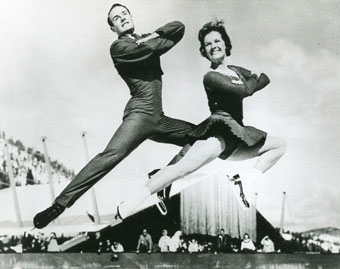
Outstanding Canadian singles men skaters of the 1960s included Donald Jackson, who placed third in the 1960 Olympics and won the 1962 World Championships, and Donald McPherson, who won the 1963 world title. Jackson distinguished himself by being the first skater to successfully land a triple lutz jump in international competition (a triple lutz jump is a jump from a backward outside edge, assisted by the toe pick, with three revolutions in the air).
A number of women singles skaters also gained international recognition in the early 1960s. Wendy Griner placed second in the 1962 World Championships, the same year that a young Petra Burka demonstrated her potential by executing a triple salchow jump — the first by a woman in competition (a triple salchow is a jump from the back inside edge of one foot to the back outside edge of the other foot, incorporating three revolutions in the air). Burka placed third in the 1964 Olympics and the following year won the World Championship.
The 1970s were dominated by the innovative skater Toller Cranston, who was Canadian champion from 1971 to 1976. He won the free-skating segment of the World Championship four times and was awarded the bronze medal in the 1976 Olympics. In the early 1970s, after overcoming stress fractures in both legs, Karen Magnussen placed second in the 1972 Olympics and won the 1973 world title. Vern Taylor added to the list of jumping firsts by Canadians when he became the first person to successfully land a triple axel jump in competition, at the 1978 World Championships in Ottawa, ON (a triple axel jump consists of three and a half revolutions in the air from a forward skate edge).

Canadian Medal Winners, 1980–88
In the 1980s, Canadian skaters were again among the world's best. In 1984, Barbara Underhill of Oshawa, ON, and Paul Martini of Woodbridge, ON, culminated a long career by winning the pairs world championship in Ottawa. Brian Orser of Belleville and Penetanguishene, ON, holder of the Canadian senior men’s title from 1981 to 1988, placed third at the world championship in 1983, followed by three years in second place and a silver medal at the 1984 Olympic Games. In 1987, he won the world title and became the first competitor to complete two triple axels successfully in one program. In 1988, Canadians produced medals in three of the four skating disciplines at the Olympics in Calgary: Orser won his second consecutive Olympic silver, Elizabeth Manley won the women's silver, and, in ice dancing, Tracy Wilson and Robert McCall won the bronze. All three performances were repeated at the 1988 Worlds.

Canadian Medal Winners, 1989–2000
Kurt Browning, who in 1988 executed the first quadruple jump in competition, replaced Orser as Canadian champion in 1989 and then won three consecutive world championships (1989–91). In 1992, Browning won silver at the world championships, while fellow Canadian Elvis Stojko won the bronze medal. In 1993, Browning and Stojko staged a thrilling duel for the men's title, with Browning winning his fourth championship and Stojko placing second. Elvis Stojko captured three world titles between 1994 and 1997, as well as an Olympic silver medal in 1998 at Nagano. He also won a silver medal at the World Championships in 2000.
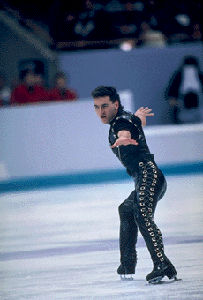
Browning and Stojko’s success was in part a reflection of the elimination of compulsory figures from singles competition in 1990; in the past, the emphasis on compulsory figures had affected Canadian skaters, such as Karen Magnussen and Brian Orser, who were strong athletically and artistically, but not as skilled in figures. With the change, the athletic and artistic aspects of figure skaters’ programs had greater weight in judging.
Canadian skaters were also successful in pairs competition, with Lloyd Eisler and Isabelle Brasseur taking the bronze medal in pairs at the 1992 Olympics in Albertville. Eisler and Brasseur also won silver medals at both the 1990 and 1991 World Championships and a bronze at the 1992 Worlds, before winning gold in 1993.
The 1991 world champions in ice dance were Isabelle and Paul Duchesnay, Canadian skaters who competed for Canada until 1985, when they left to represent France. The Duchesnays, noted for their innovative approach to ice dance, were also the 1992 Olympic silver medalists. Ice dancers Shae-Lynn Bourne and Victor Kraatz won three bronze medals at the 1996, 1997 and 1998 World Championships. They placed a controversial fourth in the 1998 Olympic Winter Games, amidst accusations of vote fixing among some of the judges (some felt that Bourne and Kraatz should have finished on the podium).
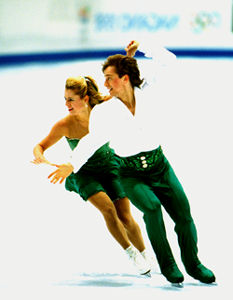
Skategate and the 2002 Olympics
The 2002 Olympics at Salt Lake were memorable for Canadian figure skaters, particularly because of what became known as “Skategate,” a judging scandal that affected the pairs competition. The Canadian pairs team of Jamie Salé and David Pelletier had dominated world competition in 2001, winning all four of the major competitions, including the world championships in Vancouver. At the 2002 Olympic Winter Games, Salé and Pelletier lost to the Russian pairs team, Elena Bereznaya and Anton Sikharulidze, a decision that many felt was unfair. In the days that followed, media exposure of a possible judging scandal in the pairs event raised Salé and Pelletier to superstar status and garnered them worldwide support. Four days after the initial awarding of the medals, the International Skating Union, pressured by the International Olympic Committee to act quickly, found the French judge Marie-Reine le Gougne guilty of fraudulent judging, an act that may have prevented Salé and Pelletier from winning the gold medal many felt they deserved. As a result, double gold medals were awarded to both pairs teams at a special ceremony. Shortly after being awarded their Olympic gold medals, Salé and Pelletier announced that they would not defend their world championship title at Nagano, Japan, in March 2002.

"Skategate" appeared to be another black mark on the sport, which had suffered from the Nancy Kerrigan/Tonya Harding scandal in 1994 at Lillehammer and the controversy surrounding judging at the ice dancing competition at Nagano in 1998. However, the
2002 judging scandal resulted in some positive change, as the International Skating Union introduced a quantitative, complex new scoring system based on a written standard. Skate
The Salt Lake Games also marked the last Olympic competition for long-time competitors Elvis Stojko and the dance team of Shae-Lynn Bourne and Victor Kraatz.
Canadian medal favourite, Emanuel Sandhu, withdrew shortly before competition due to a knee injury, leaving Stojko as the sole male to represent
Canadian Medal Winners, 2003–10
In 2003, Bourne and Kraatz won the ice dance gold medal at the World Championships, a first for any North American pair in the USSR- and Russia-dominated event. In 2006, men's skater Jeffrey Buttle won bronze at the Torino Olympics, and young ice dancers Tessa Virtue and Scott Moir won the first Canadian gold medal at the World Junior Championships. In 2008, Buttle's success continued when he won the 2008 World Championship title, the first Canadian man since Elvis Stojko in 1997 to win the event.
Canada reached a milestone in ice dancing at the 2010 Vancouver Olympic Winter Games. On 22
Feb 2010, skaters Tessa Virtue and Scott Moir won the gold medal, the youngest-ever Olympic winners in the sport. After outstanding scores in the compulsory and original dances, the dance team was favoured to win a spot on the podium. They skated a personal
best in the free dance, earning 110.42 points for a total of 221.57, and edging out their

The 2010 Games also marked the first time a Canadian woman singles skater reached the podium since Elizabeth Manley's silver medal win in 1988. Joannie Rochette, whose mother had died of a heart attack only days before the competition, skated an emotional performance in both the long and short programs to secure a bronze medal finish.
At the 2010 World Championships, Canada’s Patrick Chan took the silver medal in men’s singles competition, while Virtue and Moir won gold in the ice dance competition.
Canadian Figure Skating, 2011–14
Patrick Chan won the World Championships in 2011, with the judges awarding him a world record total score of 280.98. The following two years (2012–3) saw Chan become the third Canadian man (after Browning and Stojko) to win three world championships. Virtue and Moir placed second in ice dancing at the 2011 world championships, first in 2012, and second again in 2013. In 2013 and 2014, the pair-skating team of Meagan Duhamel and Eric Radford won world bronze in the pairs event.
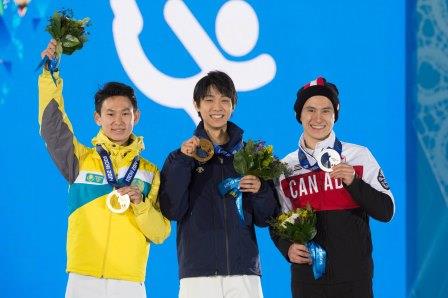
At the 2014 Winter Olympics a new figure skating team event was added, with the Canadian team earning the silver medal in that inaugural event. Patrick Chan, despite being touted at home to win the men’s singles competition, experienced some difficulties during his skate and finished in second place. Virtue and Moir, despite breathtaking performances, finished second in the ice-dance event; the result led to some controversy about the coaching and judging (see Virtue and Moir). Neither Chan nor Virtue and Moir competed in the 2014 world championships.

Canadian Figure Skating, 2015–Present
In 2015, new national champions arose in the absence of Patrick Chan, Tessa Virtue and Scott Moir, who opted for a break from competition. Nam Nguyen became the new Canadian men’s champion, and Kaitlyn Weaver and Andrew Poje the new ice dance champions. Gabrielle Daleman won her first women’s title.
At the 2015 World Championships, Meagan Duhamel and Eric Radford earned gold with 221.53 points after winning both the short and free programs. Weaver and Poje took home an ice-dance bronze medal.
Duhamel and Radford reigned supreme in the pairs field at the 2016 World Championships, winning their second world title with a total of 231.99 points. Canadian pairs dominated the competition, with three couples finishing in the top ten. The men’s event marked the return of Chan, who finished in fifth place, as well as a strong trend toward younger skaters who incorporated multiple quadruple jumps in their programs.
At the 2017 Canadian championships, Duhamel and Radford won a record-breaking sixth consecutive national title. Virtue and Moir returned to competition and another national ice dance title, while Chan continued his streak of men’s titles. Kaetlyn Osmond won her first national ladies’ title, following that with a silver medal at the World Championships after finishing second in both the short and free programs. Gabrielle Daleman won bronze in the same event, making it the first time that Canada placed two women on the podium at the world championships. Virtue and Moir won another gold medal at the world championships. Altogether, Canada placed two men, two women, two dance teams, and two pairs in the top 10.
At the 2018 national championships, Chan earned a record-setting 10th national title while Duhamel and Radford won their seventh title and Virtue and Moir their eighth. Daleman regained her crown from Osmond in the ladies’ event.
Then came the 2018 Winter Olympics, the highlight of the four-year cycle. Canadian skaters earned four medals — the country’s highest Olympic medal count in figure skating to that point. The first medal was gold in the team event, defeating the Olympic Athletes from Russia, who took second place. Team Canada members were Chan, Osmond, Daleman, Duhamel, Radford, Virtue and Moir. Virtue and Moir then took their second career Olympic ice-dance gold (their main competitors being Gabriella Papadakis and Guillaume Cizeron from France). They finished the competition with 206.07 points, the second-highest score ever posted in an ice dance event. In the pairs event, Duhamel and Radford earned bronze with a throw quadruple Salchow jump (an Olympic first); it was Canada’s first Olympic pairs medal since 2002. The fourth medal was Osmond’s bronze medal in the ladies’ event. It was Canada’s 27th medal at the Games, surpassing Canada’s previous record of 26 medals at the Vancouver Olympic Winter Games.
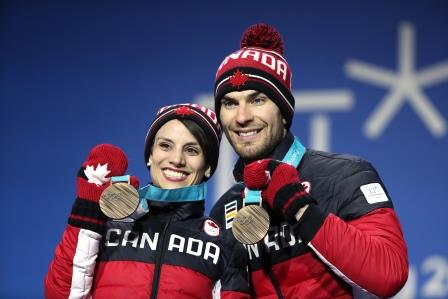
Olympic medallists Chan, Duhamel, Radford, and Virtue and Moir did not compete at the 2018 world championships the following month. However, Osmond did compete, winning an unexpected but decisive gold in the women’s event, leaping from fourth position after the short program and performing seven triple jumps in the free skate for a score of 223.23. Osmond’s gold made her the first Canadian women’s world champion since Karen Magnussen in 1973. In ice dance, Weaver and Poje earned the bronze medal with 192.35 points, a personal best.
In total, Canadian skaters won 28 international medals at the senior level during the 2017–18 season.
World Championships in Canada
Canada first hosted the International Skating Union’s World Championships in 1932 in Montréal. Since then, the event has taken place in Canada several times: Vancouver (1960), Calgary (1972), Ottawa (1978 and 1984), Halifax (1990), Edmonton (1996), Vancouver (2001), and London, ON (2013).
Synchronized Skating
Synchronized skating (formerly called precision skating) is a team figure skating event in which 8 to 20 skaters move as a unit to perform large-scale choreographed formations and patterns such as wheels and lines. The popularity of competitive synchronized
skating is growing in
The World Synchronized Skating Championships have been held in Canada twice, in Ottawa, Ontario, in 2003, and Hamilton, Ontario, in 2015.
Ice Shows in Canada
Since the 1930s, ice shows have been popular in Canada; these costumed spectacles feature professional figure skaters backed by large ensemble casts of skaters performing production numbers similar to Vegas shows. The Toronto Skating Club staged skating “Carnivals” in Maple Leaf Gardens in the mid-1930s, featuring ice ballets as well as Olympic champions and international skating stars. However, most of the early ice shows seen in Canada were by travelling American troupes such as Ice Follies, which first performed in Toronto in 1941, and Ice Capades, which appeared in Toronto in 1943 and at the Montreal Forum in 1944 and returned annually thereafter, often appearing in other Canadian cities as well. In December 1938, the Hollywood Ice Revue, an ice show featuring Olympic champion Norwegian Sonja Henie and Canadian pairs champion Stewart Reburn, drew a large crowd in Toronto.
Among the Canadian skaters who performed with Ice Capades, Ice Follies and other ice shows were Michael J.R. Kirby, Barbara Ann Scott, Barbara Wagner and Robert Paul, Linda Carbonetto, Toller Cranston (who also had his own show, Toller Cranston’s The Ice Show, in the mid-1970s), Maria and Otto Jelinek, Guy Revell, Brian Pockar, Lynn Nightingale, Barbara Ann Underhill and Paul Martini, Elizabeth Manley, Ron Shaver, and Kay Thomson. More recently, a number of Canadian figure skaters have performed with Stars on Ice, including Cranston, Shae-Lynn Bourne and Victor Kraatz, Isabelle Brasseur and Lloyd Eisler, Tessa Virtue and Scott Moir, Kurt Browning, Jeffrey Buttle, Patrick Chan, Josée Chouinard, Meagan Duhamel and Eric Radford, Cynthia Phaneuf, Joannie Rochette, and Elvis Stojko.
Figure Skating on Television
Television broadcasts of figure skating competitions reach large audiences in

 Share on Facebook
Share on Facebook Share on X
Share on X Share by Email
Share by Email Share on Google Classroom
Share on Google Classroom





